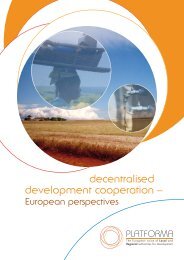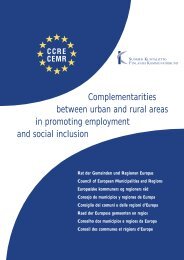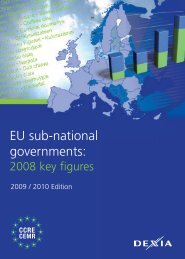The impact of demographic change on local and regional government
The impact of demographic change on local and regional government
The impact of demographic change on local and regional government
Create successful ePaper yourself
Turn your PDF publications into a flip-book with our unique Google optimized e-Paper software.
1 Introducti<strong>on</strong> >2 Demographic Changes in Europe > 3 Demographic Change in Four Policy fields > 4 Summary <strong>and</strong> C<strong>on</strong>clusi<strong>on</strong>> 5 Further Inquiry <strong>and</strong> Research Questi<strong>on</strong>s > 6 <str<strong>on</strong>g>The</str<strong>on</strong>g> Council <str<strong>on</strong>g>of</str<strong>on</strong>g> European Municipalities <strong>and</strong> Regi<strong>on</strong>s in a nutshellDemographic situati<strong>on</strong> in briefSpain<str<strong>on</strong>g>The</str<strong>on</strong>g> current populati<strong>on</strong> <str<strong>on</strong>g>of</str<strong>on</strong>g> Spain is about 40.3 milli<strong>on</strong>.<str<strong>on</strong>g>The</str<strong>on</strong>g> median age is some 39.5. Life expectancy is 79.5, 76.2 formen <strong>and</strong> 83.1 for women, <strong>and</strong> thus in the same range as theother countries under study. <str<strong>on</strong>g>The</str<strong>on</strong>g> total fertility rate <str<strong>on</strong>g>of</str<strong>on</strong>g> 1.28children born per woman is <strong>on</strong>e <str<strong>on</strong>g>of</str<strong>on</strong>g> the lowest in the EU (31) .<str<strong>on</strong>g>The</str<strong>on</strong>g> Spanish populati<strong>on</strong> will decrease by 9.4 milli<strong>on</strong> over thecoming 50 years, according to a report by the United Nati<strong>on</strong>s'populati<strong>on</strong> divisi<strong>on</strong>. This represents a 24% net loss in currentpopulati<strong>on</strong>. In 2050, Spain will be the country with the highestpercentage <str<strong>on</strong>g>of</str<strong>on</strong>g> old people in the world. Currently, the over65 age group makes up 17% <str<strong>on</strong>g>of</str<strong>on</strong>g> the Spanish populati<strong>on</strong>.If current trends c<strong>on</strong>tinue, this will rise to 37% by 2050, whichrepresents a total increase <str<strong>on</strong>g>of</str<strong>on</strong>g> 117% for this age group bythat year (32) .Spain has also evolved from being an emigrati<strong>on</strong> state intoan immigrati<strong>on</strong> state, most str<strong>on</strong>gly since the beginning <str<strong>on</strong>g>of</str<strong>on</strong>g>the 1990s. Accessi<strong>on</strong> to the EU in 1986 <strong>and</strong> a c<strong>on</strong>sequentec<strong>on</strong>omic growth have made Spain more attractive forre-migrants <strong>and</strong> also for immigrants from Africa,Asia <strong>and</strong> LatinAmerica. <str<strong>on</strong>g>The</str<strong>on</strong>g> present proporti<strong>on</strong> <str<strong>on</strong>g>of</str<strong>on</strong>g> foreigners in the countryis about 3.2%. At the end <str<strong>on</strong>g>of</str<strong>on</strong>g> 2002 immigrants from Africancountries were the biggest group (27.7%), three quarters <str<strong>on</strong>g>of</str<strong>on</strong>g>them originating from Morocco. <str<strong>on</strong>g>The</str<strong>on</strong>g>y were followed by peoplefrom Latin America. Main regi<strong>on</strong>s for immigrants to settle areMadrid, Catal<strong>on</strong>ia <strong>and</strong> Andalusia, engendering problems <str<strong>on</strong>g>of</str<strong>on</strong>g>integrati<strong>on</strong>, housing, employment, etc (33) .Interregi<strong>on</strong>al migrati<strong>on</strong> between 1960 to 1973 was veryintense due to the str<strong>on</strong>g ec<strong>on</strong>omic growth with substantialregi<strong>on</strong>al imbalances that prevailed at the time. People left rural<strong>and</strong> poor areas like Andalusia <strong>and</strong> Extremadura for wealthier<strong>and</strong> more industrial z<strong>on</strong>es like Madrid, Catal<strong>on</strong>ia or the BasqueCountry. However, since the early 1980s <strong>and</strong> well into the1990s, net interregi<strong>on</strong>al flows declined substantially despitethe persistence <str<strong>on</strong>g>of</str<strong>on</strong>g> regi<strong>on</strong>al differentials <strong>and</strong> sustained highunemployment (34) .Compared to Finl<strong>and</strong> <strong>and</strong> Germany, <str<strong>on</strong>g>demographic</str<strong>on</strong>g> <str<strong>on</strong>g>change</str<strong>on</strong>g> inSpain has been influenced by rapid industrialisati<strong>on</strong> <strong>and</strong>modernisati<strong>on</strong> during the transiti<strong>on</strong> from the Franco era to EUmembership.Demography-related nati<strong>on</strong>al policiesRecent developments in family policy (35) in Spain show that thecountry has entered a new era <str<strong>on</strong>g>of</str<strong>on</strong>g> explicit family policy.This was already the case under the former c<strong>on</strong>servative<strong>government</strong> with its family programme (Plan Integral deProtección de la Familia) adopted in 2001 but also with themain oppositi<strong>on</strong> party (Socialist Party), now in power, whichpresented its own programme for the family. After animportant reform <str<strong>on</strong>g>of</str<strong>on</strong>g> the fiscal system in 1998, a new incometax reform was adopted in 2002 <strong>and</strong> implemented in 2003.<str<strong>on</strong>g>The</str<strong>on</strong>g> reform has introduced many <str<strong>on</strong>g>change</str<strong>on</strong>g>s relating to families,especially children. <str<strong>on</strong>g>The</str<strong>on</strong>g> reform includes a financialcompensati<strong>on</strong> to mothers during the three years followingbirth which is not limited by the level <str<strong>on</strong>g>of</str<strong>on</strong>g> income, together withan increase in tax relief for childcare beginning with thesec<strong>on</strong>d child instead <str<strong>on</strong>g>of</str<strong>on</strong>g> the third as before. <str<strong>on</strong>g>The</str<strong>on</strong>g> aut<strong>on</strong>omousregi<strong>on</strong>s have also c<strong>on</strong>centrated their new fiscal competence<strong>on</strong> ec<strong>on</strong>omic support for the family.In migrati<strong>on</strong> policy, the Spanish <strong>government</strong> enacted a newregulati<strong>on</strong> in December 2004 <strong>on</strong> the legalisati<strong>on</strong> <str<strong>on</strong>g>of</str<strong>on</strong>g> illegalimmigrants in Spain. According to this regulati<strong>on</strong>, migrantsliving illegally in Spain may receive a residence <strong>and</strong> a workpermit if they have lived in Spain for at least <strong>on</strong>e year <strong>and</strong> ifthey have a work c<strong>on</strong>tract for at least six m<strong>on</strong>ths. Migrantswho do not apply for legalisati<strong>on</strong> within this period will haveto apply according to the ordinary procedure to obtain legalpapers for humanitarian reas<strong>on</strong>s (36) .(31) <str<strong>on</strong>g>The</str<strong>on</strong>g> World Factbook, Spain (http://www.cia.gov/cia/publicati<strong>on</strong>s/factbook/geos/sp.html#People).(32) British Medical Journal, Spain faces massive decline in populati<strong>on</strong> (http://www.pubmedcentral.nih.gov/articlerender.fcgi?artid=1117826).(33) Bundeszentrale politische Bildung, Länderpr<str<strong>on</strong>g>of</str<strong>on</strong>g>il Spanien (http://www.migrati<strong>on</strong>-info.de/migrati<strong>on</strong>_und_bevoelkerung/artikel/031005.htm).(34) Bover, Olympia; Velilla, Pilar, Migrati<strong>on</strong>s in Spain: Historical Background <strong>and</strong> current trends, December 2001 (http://rt001hfd.eresmas.net/Paper-graf.pdf).(35) Cord<strong>on</strong>, Juan, General M<strong>on</strong>itoring Report 2004 Spain, Families in Spain: Policies, challenges <strong>and</strong> opportunities (http://www.europa.eu.int/comm/employment_social/eoss/downloads/gm_04_Spain.pdf).(36) european-migrati<strong>on</strong>-law.net, Illegal Immigrati<strong>on</strong> – Spain legalises illegal migrants (http://www.european-migrati<strong>on</strong>-law.net/modules.php?name=News&file=article&sid=158).














![[ ] Les jumelages pour le monde de demain](https://img.yumpu.com/29721946/1/190x96/-les-jumelages-pour-le-monde-de-demain.jpg?quality=85)

